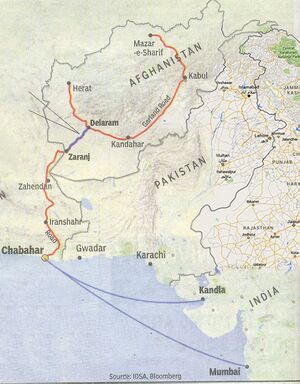Mazar-i-Sharif

Mazar-i-Sharif or Mazar-e-Sharif (Persian/Pashto: مزارِ شریف, ˌmæˈzɒːr ˌi ʃæˈriːf) is the third-largest city of Afghanistan. It is the capital of Balkh province.
Location
It is linked by highways with Kunduz in the east, Kabul in the southeast, Herat in the west and Uzbekistan in the north. Mazar-e Sharif, along with Herat, Jalalabad in the east and Kandahar in the south, makes Afghanistan an important strategic location in Asia. The city also serves as one of the many tourist attractions because of its famous shrines as well as the Muslim and Hellenistic archeological sites. In 2006, the discovery of new Hellenistic remains was announced.[1]
Origin of name
The name "Mazar-e Sharif" means "Noble Shrine", a reference to the large, blue-tiled sanctuary and mosque in the center of the city known as the Shrine of Hazrat Ali or the Blue Mosque. Some Muslims believe that the tomb of Ali ibn Abi Talib, the cousin and son-in-law of the Islamic prophet Muhammad, is at this mosque in Mazari Sharif, after Ali's remains were transferred to Mazar-i-Sharif as per request of Ja'far as-Sadiq. However, most Muslims believe that the grave of Ali is at the Imam Ali Mosque in Najaf, Iraq.[2]
History
Mazar-i-Sharif is the Regional Hub located in the northern region in close proximity to Uzbekistan and Tajikstan.
The region around Mazar-e-Sharif has been historically part of Greater Khorasan and was controlled by the Tahirids followed by the Saffarids, Samanids, Ghaznavids, Ghurids, Ilkhanates, Timurids, and Khanate of Bukhara until the mid-18th century when it became part of the Durrani Empire after a friendship treaty was signed between emirs Murad Beg and Ahmad Shah Durrani.
According to tradition, the city of Mazari Sharif owes its existence to a dream. At the beginning of the 12th century, a local mullah had a dream in which the 7th century Ali bin Abi Talib, cousin and son-in-law of Muhammad, appeared to reveal that he had been secretly buried near the city of Balkh.
The famous Jalal al-Din Rumi was born in this area but like many historical figures his exact location of birth cannot be confirmed. His father Baha' Walad was descended from the first caliph Abu Bakr and was influenced by the ideas of Ahmad Ghazali, brother of the famous philosopher. Baha' Walad's sermons were published and still exist as Divine Sciences (Ma'arif). Rumi completed six books of mystical poetry and tales called Masnavi before he died in 1273.
After conducting researches in the 12th century, the Seljuk sultan Ahmed Sanjar ordered a city and shrine to be built on the location, where it stood until its destruction by Genghis Khan and his Mongol army in the 13th century. Although later rebuilt, Mazar stood in the shadow of its neighbor Balkh. During the nineteenth century, due to the absence of drainage systems and the weak economy of the region, the excess water of this area flooded many acres of the land in the vicinity of residential areas causing a malaria epidemic in the region. Thus the ruler of North Central Afghanistan decided to shift the capital of the city of Mazar-e-Sharif.[3]
The city along with the region south of the Amu Darya became part of the Durrani Empire in around 1750 after a treaty of friendship was reached between Mohammad Murad Beg and Ahmad Shah Durrani, the founding father of Afghanistan. In the late 1870s, Emir Sher Ali Khan ruled the area from his Tashkurgan Palace in Mazar-i Sharif. This northern part of Afghanistan was un-visited by the British-led Indian forces during the Anglo-Afghan wars of the 19th century.
References
- ↑ "Balkh Monument". BBC Persian
- ↑ Shaykh Al Mufid. Kitab al Irshad, Translated by I.K.A Howard. pp.1-6
- ↑ Welcome afghanmagazine.com - Justhost.com
Back to Jat Places in Afghanistan

